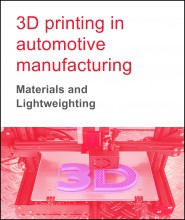
3D printing in automotive manufacturing
To comply with emissions targets, OEMs must consider all options, including new materials that reduce vehicle mass. Additionally, OEMs and suppliers need to examine new construction materials and techniques to reduce costs, ensure greater cradle-to-grave sustainability, and support innovative design features.
This report will help automotive OEMs, Vendors as well as relevant stakeholders in automotive manufacturing technology to have a grasp around the history, technology, enablers, and constraints around additive manufacturing. The report deals in detail about the application areas of 3D printing in automotive and its effect on products, design process, tool making processes, supply chain and logistics in the automotive industry.
It also forecasts the printing speed and production quality parts of 3D printing from an IHS Markit standpoint.
Focus areas of the report include:
- Drivers of additive manufacturing usage and the potential challenges impeding its large-scale adoption in the automotive industry
- The supplier-OEM landscape, such as product launches and strategic growth opportunities for existing and new players
About Additive Manufacturing
Additive manufacturing or 3D printing can be most commonly defined as the process of manufacturing an object in three dimensions through the layer-by-layer deposition of building materials with the help of a computer-guided printer jet. The process allows for both simulation and rapid prototyping with multiple iterations, thereby reducing the total development time and allowing for the actual printing of functional parts. Having started in the early 1980s, the process underwent a number of significant improvements and is now threatening to disrupt the traditional manufacturing processes, such as casting and forming, to an extent. The technology offers digital remote control of operations and is a major tool toward the integrated Industry 4.0 push across sectors.





